Why does the gas column go out: typical causes and a guide to resolve them
Any household appliances periodically break down, and a gas water heater is no exception. With timely cleaning and compliance with the operating rules, such a device works properly. But if the appliance does not turn on or the flame goes out immediately, serious damage may be detected.
To understand why the geyser goes out, we will understand the features of its structure and functioning. Also in this article we will consider the popular reasons for the fading of the column and ways to restore its performance. We supplemented the presented material with visual photos and informative videos.
The content of the article:
The device and principle of operation of the column
Inside the column, there are two main elements: a gas burner and a heat exchanger that looks like a long narrow pipe, usually made of copper, rolled up by a snake or spiral. Cold water flows from the water supply to the coil, heats up above the burner and leaves the device when it is already hot.
Of course, everything is not so simple, since a number of important components, such as:
- ignition device or igniter;
- water-gas unit;
- solenoid valve with a set of sensors.
The ignition device often looks like a so-called standby burner: a small tongue of flame that burns constantly. In the electronic version of this unit, immediately before the column is turned on, a spark arises, which ignites the igniter. This is a more modern version, which allows even some gas savings.
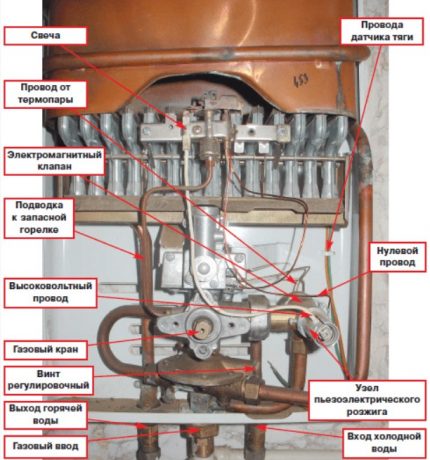
To obtain a spark, a piezoelectric element is most often used, which can also be started manually.In the models of past years, such amenities are not provided: the ignitor is lit with an ordinary match. In order for the gas to turn on automatically, a water-gas unit is needed when starting up the water. It consists of a membrane that is mounted in the water supply, and a valve in the gas path.
When the tap is opened, water begins to move, the membrane changes its position under the influence of flow and transmits a signal to the valve. It opens and starts the flow of gas to the burner, which is ignited. When the water is turned off, the membrane returns to its original position, the valve blocks the gas flow, the burner goes out.
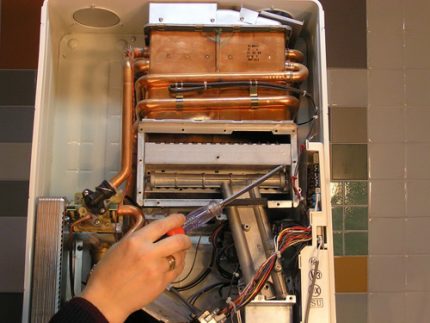
Thanks to the gas-water unit, it is not necessary to manually open the gas each time the water is turned on. The solenoid valve also regulates the gas supply in accordance with the readings of various sensors that detect the presence of flame, draft, dangerous overheating, etc.
This node is necessary to increase system security. Sensors respond to system malfunctions, and the valve shuts off gas supply if serious problems arise in the operation of the device.
In addition to sensors, a thermocouple is connected to the valve. This element responds to the presence or absence of a standby burner flame. If there is no fire, the gas entering the column will not ignite, but will accumulate, which is very dangerous.
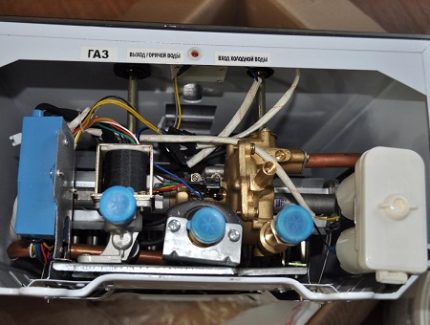
Reasons for column fading
Any of the nodes described above may cause column attenuation. The flame goes out if the security system detects a violation of normal operation. To start the device, you will need to identify and eliminate the cause of such a violation.
Here are the most common options for possible problems:
- there is no draft in the chimney;
- the main burner has gone out;
- there is a dangerous increase in water temperature in the heat exchanger;
- individual elements are worn out and require replacement.
If the column does not give a flame, first you need to make sure that its operating conditions are not violated, and check the manufacturer's warranty terms. The necessary information is contained in the technical data sheet of the product and the manual for its use.
Reason # 1 - lack of draft in the chimney
Traction testing is the easiest way to diagnose the condition of the device. You just need to bring a strip of thin paper or a flame of a lighter, matches, etc. to the viewing hole of the column. But if there is even a slight suspicion of a gas leak, it is better to refuse to use open flame.
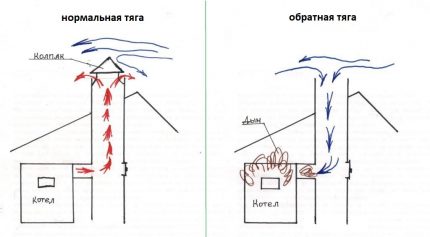
If the paper or flame pulls inward, everything is in order, traction is available. The absence of changes in their position indicates the absence of traction, and the deviation in the opposite direction indicates that there is reverse thrust.
to verify the causes of the problem, you need to disconnect the column and check the draft in the same way only in the chimney. After that, it will become clear whether there are malfunctions in the chimney duct or inside the column too.
When the chimney design is in order, the heat exchanger becomes the “culprit” of the lack of draft, or rather, the soot particles that clog it, which impede normal air exchange. It is necessary to remove the protective cover from the column and clean the heat exchanger with a hard brush.
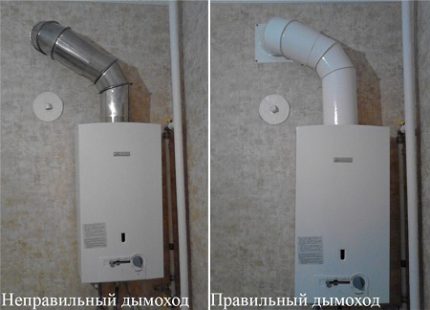
If the chimney is dirty, it remains to simply clean it and reconnect it to the device. If there is no positive reaction, you need to make sure that the chimney structure is assembled correctly from suitable materials.Sometimes the cause of lack of traction can be flaws in the installation of this section of the system.
Often problems of this type arise for external reasons, such as the lack of proper ventilation of the room. Plastic windows and a tightly closed door practically seal the room in which the speaker is located. There is no fresh air flow, so there is no movement in the chimney.
It does not hurt to check the ventilation system in the whole house or apartment.
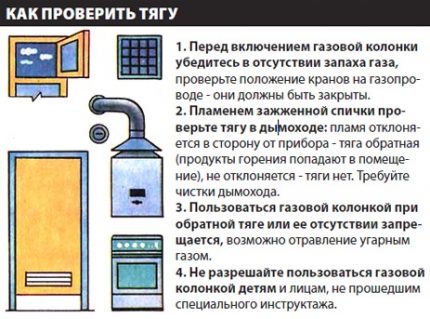
You need to make sure that a sufficient amount of fresh air enters the room. If ventilation cannot be naturally controlled, a supply valve can be installed. on the windows or into the wall.
Then you need to make sure that the air flows not only enter the house, but also move freely throughout the premises. To do this, it is necessary to install ventilation grilles on the doors or make a small clearance below.
Reason # 2 - regular burner attenuation
The absence of a standby burner flame is detected by the sensor, after which the gas supply is immediately shut off. This situation may occur if a small light was hit by a strong gust of wind. There is no need to draft indoors while working, especially if it is very windy outside.
Strong air currents can penetrate not only through windows and doors, but also through the chimney. The result may be the same - the burner goes out, the automation blocks the gas flow.
To restore normal operation of the device, turn off the column, check the status of the standby burner (a flame tongue should appear here), and turn on the device again.
Reason # 3 - significant overheating of water
This occurs when the head of the flow of water passing through the heat exchanger decreases, and the heating intensity remains unchanged. In some cases, even boiling water can be observed, which is dangerous for the integrity of the device.
Pressure decreases when cold water is opened to dilute the flow to a comfortable temperature, and cold water displaces hot water. It is better to regulate the heating using the column settings.
Another reason for the occurrence of this phenomenon is a calcareous sediment accumulated inside a narrow heat exchanger pipe. To restore normal pressure, you need to regularly descale the device, and make sure that the water is not too hot. For domestic needs, it is enough to warm the water to 45-50 degrees.
This mode helps to reduce the formation of solid sediment. If the water in the system is too hard, and you often have to clean the heat exchanger, it makes sense to think about installing a special filter that will remove it from the salt stream. Cleaning the heat exchanger is carried out using special means or household chemicals: soda, vinegar, etc.
You will have to remove the protective cover from the column, as well as block the gas and water. Then the heat exchanger is disconnected from the water supply and dismantled. Inside the coil pipe, pour the cleaning compound and leave for a while. After that, the heat exchanger is washed, installed in place and the column is reassembled.
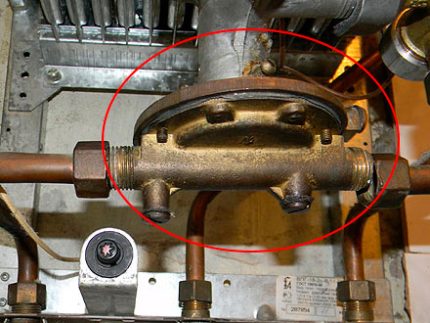
The mesh filter installed at the inlet of the tap water into the heat exchanger is periodically clogged with contaminants. It also needs to be cleaned. To remove common dirt, just rinse the net in water, but sometimes you have to use chemicals. If damage is detected on the filter, it is best to replace it immediately.
Reason # 4 - insufficient water pressure
Lack of normal water pressure in the system and without overheating, it can cause the valve to block the gas flow and the burner will go out.
In this situation, you should check the condition of the water supply system, maybe you just need to put circulation pump. Even when buying a column, you should ask about the minimum pressure values for a particular model.
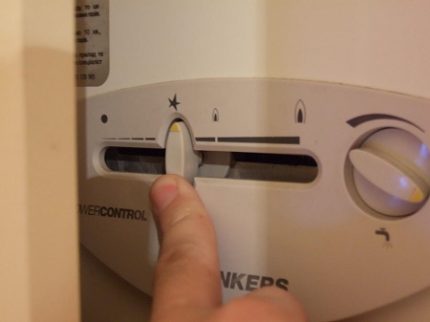
Reason # 5 - lack of timely maintenance
Following manufacturer's recommendations should be regularly clean the column. Untimely maintenance does not improve the situation. Consider the main problems that arise for this reason.
Dead batteries
If an electric ignition is provided in the column, it is carried out using batteries. The dead batteries must be replaced and the problem will be solved.
And when a piezoelectric element with a turbine is used to obtain a spark, it will not start when the water pressure is weak, this point will need to be taken into account.

Significant ignition of the igniter
The lack of an on-site burner flame often occurs when the igniter is clogged. Gas simply does not flow in enough to ignite the burner. The igniter must be cleaned with metal wire so that the column starts working.
Cleaning is best done in advance, without waiting for the hole to clog. Blockages accumulate gradually.
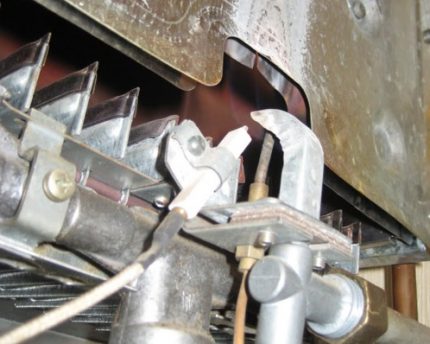
If the flame tongue has noticeably decreased, it is time to check the condition of the igniter. Another sign of the appearance of such a problem is cotton, which is heard when the burner is turned on. A weak flame is not able to immediately ignite the gas entering the device. It gradually accumulates and lights up with a pop that resembles a small explosion.
Membrane contamination or deterioration
As mentioned earlier, there is a membrane in the water-gas unit. This is a polymer element, which when in constant contact with water gradually loses its elasticity. Sometimes cracks even appear on it, limescale deposits, etc. The membrane ceases to respond to the flow of water, as a result, gas does not enter the burner.
It is necessary to disassemble the water-gas unit, remove the worn element and replace with a new membrane.
If, upon examination, it turns out that the contaminants are not too large, and the element remains elastic, you can simply rinse the membrane and install it in its original place.
In modern models with a lot of electronics, the control board may burn out, after which the speaker, of course, will not light up.
Coarse filter clogged
The reason for such a breakdown is the poor quality of power supply, for which foreign devices are not designed. In addition, some electronically controlled models should not be turned off at night, they should be turned on constantly. To solve the problem of voltage drops in the network, you can use a stabilizer.
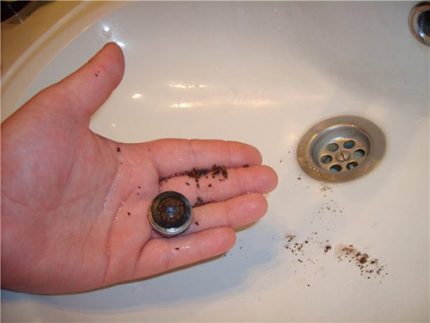
Typical problems for individual models
Even the columns of well-known companies can break down over time for a variety of reasons. During operation, device owners noticed breakdowns that most often occur with specific models.
Junkers Bosch Thermocouple Problems
For example, the weak point of the Bosch Junkers WR 13-P device is a thermocouple.
Two to three years after the start of operation, it ceases to respond normally to heating from the standby burner. As a result, the igniter flame constantly extinguishes, over time, it simply ceases to light up normally.
Sometimes it helps to clean the thermocouple with fine sandpaper, but when this method ceases to bring the desired effect, the element will have to be replaced.
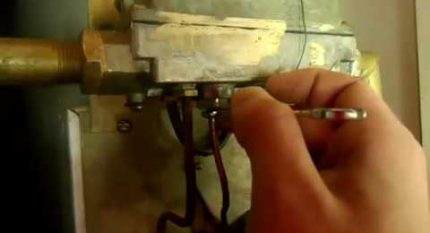
The displacement of the pilot tube, which is not fixed too firmly in similar models, can also lead to similar problems. The tube can be moved accidentally, even just hitting it with a match during ignition. Between the nozzle of the gas tube and the burner there is a gap through which air enters.
When displaced, this gap decreases, the air required for normal ignition becomes insufficient. The tongue of the flame does not reach the thermocouple, it does not heat up, gas does not enter the main burner. If you restore the normal position of the tube, the column will again work properly.
Practical recommendations for cleaning and repairing breakdowns in the JUNKERS column:
Oxidation of contacts at columns Vector
For the “Vector” columns, the oxidation of contacts in the power supply is considered a typical problem. If this is the case, replacing the dead batteries with new elements will not give the desired result, the spark will not appear until the contacts are cleaned. Sometimes in such columns souring of the microswitch rod on the water valve is observed.

After cleaning, normal operation is usually restored. If a characteristic whistle appears shortly after turning on the column, you need to check the condition of the vent pipe connections; perhaps they need re-sealing.
Problems with the stock in Neva models
In the columns of the brand "Neva" sometimes sticking of the rod in the gas valve is observed. As a result, this element stops normal operation.
To eliminate such a malfunction, it is necessary to remove and disassemble the gas-water unit, and then move the rod with an ordinary screwdriver. If the part is not amenable to mechanical stress, the element should be completely replaced.
This video demonstrates troubleshooting for the NEVA column:
Conclusions and useful video on the topic
You can look for the causes and solutions to the column attenuation problem here:
Column attenuation is a symptom of an internal malfunction or violation of the instrument's operating conditions. It is necessary to find out the cause of the problem correctly, after which a significant part of the described failures can be eliminated independently. But to solve complex problems you will have to contact a service center.
Do you have any questions while looking for the cause of the attenuation of the column? Ask them under this article - our experts and site visitors will try to help you.
Or maybe you want to tell other users about the problems that occurred with your column during operation, and their successful solution? Share your experience, leave recommendations in the block below.

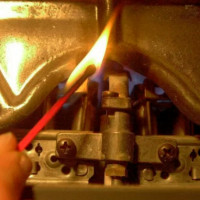 Why does the gas boiler go out? Overview of typical faults and how to solve them
Why does the gas boiler go out? Overview of typical faults and how to solve them  Why a gas boiler often turns on and off: the causes of malfunctions and their solutions
Why a gas boiler often turns on and off: the causes of malfunctions and their solutions 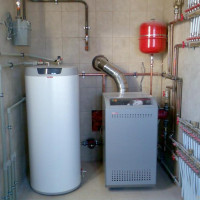 Why pressure drops in a gas boiler: causes of instability of pressure + ways to prevent problems
Why pressure drops in a gas boiler: causes of instability of pressure + ways to prevent problems 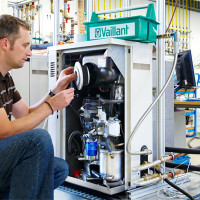 Why the gas boiler is noisy: why the unit is buzzing, clicking, whistling, clapping + how to fight
Why the gas boiler is noisy: why the unit is buzzing, clicking, whistling, clapping + how to fight 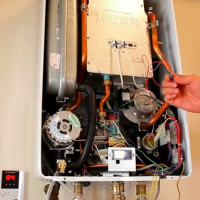 Error codes for the Master Gas boiler: decoding symbols and troubleshooting guides
Error codes for the Master Gas boiler: decoding symbols and troubleshooting guides  How to turn on the gas boiler: manual and useful recommendations for use
How to turn on the gas boiler: manual and useful recommendations for use  How much does it cost to connect gas to a private house: the price of organizing gas supply
How much does it cost to connect gas to a private house: the price of organizing gas supply  The best washing machines with dryer: model rating and customer tips
The best washing machines with dryer: model rating and customer tips  What is the color temperature of light and the nuances of choosing the temperature of the lamps to suit your needs
What is the color temperature of light and the nuances of choosing the temperature of the lamps to suit your needs  Replacement of a geyser in an apartment: replacement paperwork + basic norms and requirements
Replacement of a geyser in an apartment: replacement paperwork + basic norms and requirements
And we have a semi-automatic column “Electrolux”. The burner also constantly faded, but when the master was called, it turned out that the reason was the incorrect installation of the air duct corrugation. The representative of the gas service was mistaken initially. Hence the reduced traction. the master who came on call just removed the fuse for us, and the problem itself was solved. We just do not use hot water for a very long time, overheating does not happen here.
We once suffered with this problem - the burner is rotten, but the boiler was already well-worn. Several times they called the master, they themselves did not dare to climb there. He was cleaning something there. It helped, but not for long, and they could not establish the reason for sure. Draft, if anything, in the boiler room was not. Unfortunately, only the boiler was saved, and the problem disappeared.
The power column 1-10 when the digital display on the front panel is connected, goes out, and without it it works fine.